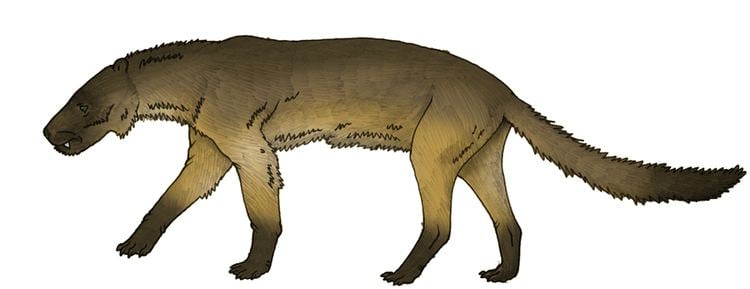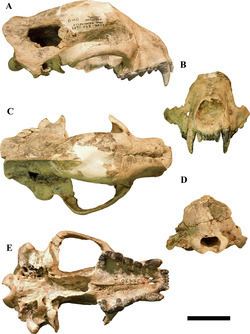Rank Genus | ||
Similar Carnivores, Plesiogulo, Potamotherium, Chamitataxus, Daphoenodon | ||
Megalictis the bone crushing giant mustelid carnivora mustelidae oligobuninae from the early
Megalictis (great weasel) is an extinct genus of large predatory mustelids, which existed in North America during the "cat gap" in the Miocene period. It is thought to have resembled a large wolverine, with a body mass of up to 60 kilograms (130 lb).
Contents
- Megalictis the bone crushing giant mustelid carnivora mustelidae oligobuninae from the early
- Description
- Discovery
- References
Description

Some writers suggest M. ferox could grow to the size of a black bear, whilst others suggest a less exceptional mass of 20–60 kilograms (44–132 lb), compared to the wolverine of 10–20 kilograms (22–44 lb). Ekorus ekakeran, a comparable mustelid of the same period found in Africa, is estimated to have been around 40 kilograms (88 lb). Matthew described it as having short stout legs, with short feet and long non-retractible claws, similar to a modern wolverine but about twice the size, and noted that "the teeth indicate an animal fully as predaceous as the wolverine, but the skeleton points to more fossorial habits". Research comparing the joints of the forelegs to modern mammalian carnivores suggests that it waited in ambush and grappled with its prey, rather than hunting it down by pursuit like a modern cheetah.
Discovery

The genus Megalictis was first described by W. D. Matthew in 1907, and assigned to the family Mustelidae. Two similar genera discovered at the same time, Aelurocyon (Peterson, 1907) and Paroligobunis (Peterson, 1910) were identified as synonymous with Megalictis in 1996 though Paroligobunis was re-established as a separate genus in 1998. P. R. Bjork, in 1970, assigned the genus to the subfamily Mellivorinae, whilst J. A. Baskin reassigned it to Oligobuninae in 1998. Three species have been identified in the genus: M. ferox, M. petersoni, and M. frazieri, whilst two more, Megalictis brevifacies and Megalictis simplicidens, have since been determined to be synonymous with M. ferox. Other synonyms of M. ferox include Aelurocyon brevifacies, Brachypsalis simplicidens and Paroligobunis simplicidens.

Specimens of M. ferox have been found at ten sites in South Dakota, Nebraska and Wyoming, dated to the Harrisonian period - from 24.8 to 20.6 million years ago. The 19 specimens so far identified have a wide range of sizes, which is believed to be evidence of extreme sexual dimorphism, a phenomenon where males and females of the species will grow to different sizes; a 1996 study rejected the possibility of multiple "morphologically uniform" but differently sized species as unlikely. However, later studies identified significant morphological variation in the joints of the forearms, which would not be consistent with sexual dimorphism. Andersson suggests that the identification of all of these as a single species may need revision.
